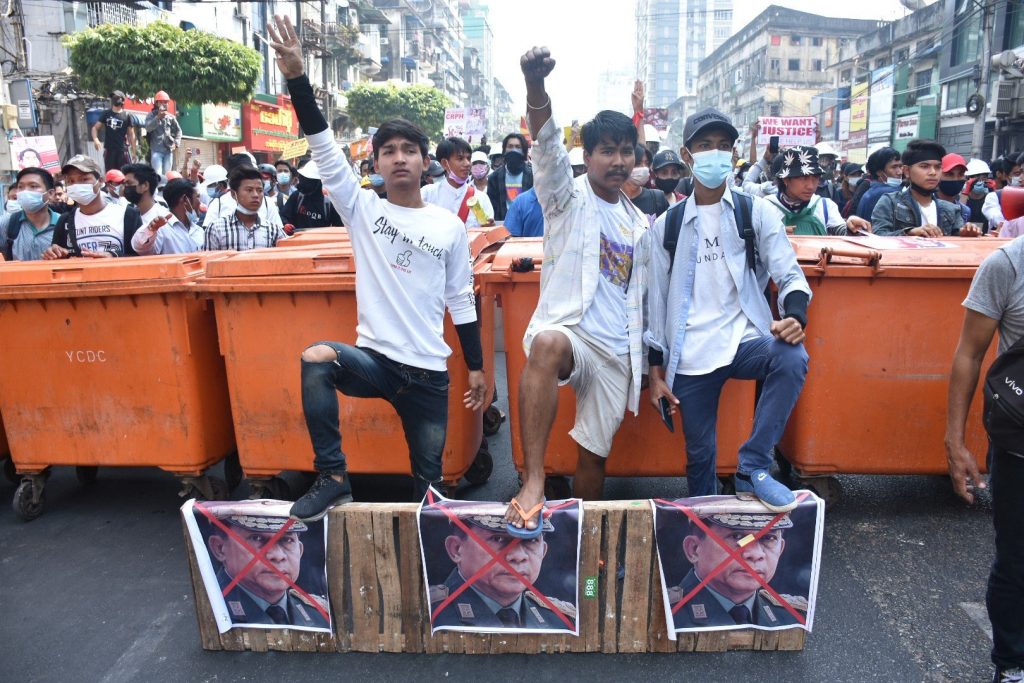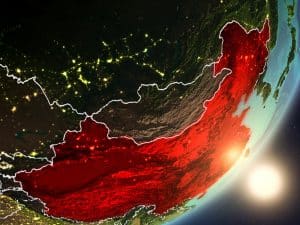Since 2020, a series of mass mobilizations has shaken the governments of South and Southeast Asia, putting the class struggle at center stage. These protests have brought together different social sectors: a huge (precarious) working class, a new middle class, students, social movements, and ethnic groups. Mostly defensive, these struggles have combined demands for better working conditions in the face of hyperexploitation and low wages. In Indonesia and India, they have centered on labor reforms; in Myanmar, the protests have sought to take down the dictatorship; in Thailand, demonstrators have demanded constitutional reforms.
These struggles are based on the material conditions created by major economic developments in the region over the past decades.
Economic Development and the Birth of a Young Working Class
These countries were born out of the post–World War II process of national liberation across the globe. For decades, their economic development was linked to agricultural production — until excess capital came calling, first from Japan, then from the “Asian Tigers” (South Korea, Hong Kong, Singapore, and Taiwan), and then with the relocation of industries from China to other destinations as part of the search for cheaper labor. These countries began to pour investments into their neighbors.
The world economic crisis that began in 1970 enhanced the region’s value as a new niche for capitalist accumulation. Since the 1980s, South and Southeast Asia have become a mecca for the global value chains of transnational corporations. Low wages, a lack of state regulations, and the absence of trade unions — as well as repressive governments in many of these countries — were characteristics appreciated by the main investors, which include multinational shoe and clothing companies such as Nike and Adidas, automakers such as Ford, General Motors, and Mitsubishi, and technology companies such as Intel.
Today, the development of the region has created a concentration of much of the world’s production and trade. Control of investment and political influence are in a state of continual dispute between regional and imperialist powers.
The region’s current growth is also linked to China’s infrastructure and productive investments as part of its Belt and Road Initiative. This program has generated a large increase in the consumption of raw materials, stimulating the extraction of resources in the region, as well as a notable level of economic dependence and accelerated indebtedness. The signing of bilateral agreements established special economic zones that integrate both resource extraction and the building of factories producing goods of low and medium complexity. At the same time, there has been competition among countries to attract new investments. After years of sustained growth exceeding 6 percent per year (reaching 14 percent in China), the average Chinese industrial worker earns about US$700 per month compared to US$250 in Vietnam, US$140 in Laos, US$130 in Cambodia, and US$110 in Myanmar, according to the Wall Street Journal.
The Philippines, Malaysia, Indonesia, and Thailand have transformed — albeit at different paces — from agrarian countries to important manufacturing centers, even though a large part of their populations remains rural. Following the “Chinese model of development,” Vietnam, Cambodia, Laos, and Myanmar have taken the path to industrialization based on foreign investment along with centralized state control of the economy (inheriting what were once deformed workers’ states). The following graph (based on World Bank data) shows the decrease in rural populations.

The structural changes in the economies of countries in the region have turned central cities such as Bangkok, Kuala Lumpur, and Hanoi into spaces for accumulation and exploitation of hyperprecarious labor. This objective increase of the working class can be seen in the following graph (based on World Bank data).

This productive constellation of South and Southeast Asia has given birth to an extended working class that coexists with rural workers in subsistence conditions. The enormous growth of the working class in these decades, together with the unbearable conditions of exploitation, established the bases for new trade unions to be formed. Unions independent of the state have required a long political struggle, depending on the country. In Vietnam, for instance, the huge mass of people displaced from the countryside became a large flow of migrant workers, linked to the major global companies — and they have in turn established networks of activists across borders.
In the same vein, women’s participation in industry and services has increased since the mid-1960s as these countries gradually became export-oriented manufacturing economies. Women, earning much lower wages, became essential for factory work, mainly in textiles — which, coupled with workplace harassment — pushed women to the front lines of the workers’ movement.
Meanwhile, millions of Cambodians, Burmese, and Bengalis (19 million men and 4 million women, according to the International Labour Organization) were pushed to cross the border in search of better opportunities. Their precarious conditions led them to establish solidarity and protection networks in the countries where they face brutal discrimination. Tens of thousands of Burmese, for example, work in the 400 textile factories of the Mae Sot region of Thailand. There, they established institutions such as the Yaung Chi Oo Workers’ Association, together with a dozen NGOs, which organizes migrant workers to fight for minimal rights.
The already-degraded living conditions of migrant workers have been hit hard by the pandemic. Millions were laid off as hundreds of textile factories closed with the disruption of supply chains from China. This left them stranded without social protections, with no work, and with no money, in addition to suffering discrimination based on their nationality in countries such as Thailand, Taiwan, and Singapore.
Parallel to these developments, a middle class has grown, and large numbers of young people have entered universities. This has created a social base for various democratic demands, ranging from the expansion of limited rights to demands for democratic openness, against the privileges of the monarchy, and against the power of the military, coup attempts, and so on. As we see in Myanmar today, these two newly emerged sectors — proletarians and university students — are in the streets with their own demands and are behind the most basic, defensive, and unifying struggle against the coup.
A Center of Gravity of the World Class Struggle
A Region in Turmoil
South and Southeast Asia are the focus of enormous social unrest, as the report from global risk and strategic consulting firm Maplecroft exposes. There are a host of examples from recent years: the struggle of young people and workers in Hong Kong against Chinese rule; the demonstrations in the Philippines against the police brutality encouraged by the ultra-right-wing government of Rodrigo Duterte; protests in Vietnam against Chinese interference; actions by thousands of health workers in Bangladesh; and factory struggles throughout the region’s textile industry, so severely affected by the disruption of supply chains during the pandemic. Firms such as H&M laid off thousands of workers during 2020.

In some cases the wildcat strikes in response to the layoffs succeeded in imposing workers’ demands (Thailand, Vietnam, and India). Since 2020, major firms have been hit by strike waves, with tens of thousands of participants demanding protection from Covid-19 and layoffs, as in the examples of Praegear Vietnam and Seethings Chi Hung.
The largest, most significant examples are analyzed below.
Myanmar
This long process of struggle and organization of the modern working class in South and Southeast Asia is here to stay. In some cases, it even seems to take on a political character, as in Myanmar — where the working class has been at the head of the struggle against the February 1 coup d’état.
The coup ousted the government of the National League for Democracy (NLD), which had won 86 percent of the votes in the last elections. The leader of the party, Aung San Suu Kyi, the country’s most important political figure, was imprisoned along with other members. Despite their call for “calm and restraint,” thousands took to the streets to protest the coup. In addition, during its years in government, the NLD maintained all the privileges of the army and business interests. The military leadership owns Myanmar’s two largest conglomerates: Myanmar Economic Holdings Limited and Myanmar Economic Corporation. The two companies have at least 120 subsidiaries and close ties to some 27 other companies.

The army’s wide variety of business activities include banking and insurance, tourism, jade and ruby mining, timber, construction, and production of palm oil, sugar, soap, cement, beverages, drinking water, coal, and gas. Its companies also own a large amount of real estate. It was these companies that financed the genocide of the Rohingya (an ethnic group in the Rakhine region), the repression of another 100 or so other ethnic groups across the country, LGBTQ people, and the working class — all with the support of the NLD.
For these reasons, the struggle has become more focused on maintaining rights than giving political support to the ousted government, as the Myanmar expert Stephen Campbell explains. An experienced and organized working class — mainly from textile factories — took to the streets together with thousands of students, LGBTQ activists, peasants, and different ethnic groups.
This response was possible only because of the development and formation of a young generation of industrial workers who have accumulated experience since the beginning of this century in struggles over wages and working conditions — from which independent and clandestine unions emerged and were later legalized.
Organized confrontations with the bosses deepened with the transition to democracy in 2011. This allowed — among other things — the legalization of unions, which were invigorated to fight for better living conditions. Things did not improve, however, under the government of the National Democratic League in the period before the coup, despite, for example, a strike at the Chinese-owned Fu Yuen garment factory, which got a lot of media coverage when the company violently quelled the strike. Fu Yuen workers had gone on strike in late August 2018, demanding better working conditions, an end to corporate harassment, and the reinstatement of 30 workers fired for union organizing. After an encampment and clashes with company thugs, the workers won the reinstatement of all those who had been let go.
Another example unfolded in May 2020, when some 300 women workers at the Rui-Ning textile factory were fired shortly after signing up for a union. Among those dismissed was Kyaw Thu Zaw, the union president. A similar case occurred at the Huabo Times factory, where 100 women workers were fired after forming a union. After months of struggle, with complaints about the lack of protections against Covid-19, permanent sit-ins in front of the factory, and appeals for international solidarity, the workers were reinstated. In fact, during the coronavirus pandemic, more than 200 factories announced closures, and there were tens of thousands of layoffs in textile factories; the Covid-related closings were used as a way to fire (and even arrest) trade union leaders who had organized resistance.

This experience led the working class, together with various sectors of civil society, to challenge the coup. Migrant workers from Myanmar in India, Thailand, and Indonesia also held demonstrations in those countries, with the support of the local population. All this led to the largest demonstration in Myanmar history on February 22, with 20 million people in the streets according to media reports (Myanmar has 54 million inhabitants), in what protesters called “Revolution 22222.” In addition, there are regions where the population does not recognize the dictatorship and has put in charge its own elected municipal leaders.
Beyond this, all ethnic and religious groups have joined the struggle against the coup, including the Rohingya. As Open Democracy puts it, “Resistance to [the] military coup is doing away with the country’s long-standing divisions of ethnicity, religion, domicile, and occupation.”
Nothing has abated. Massive demonstrations continue in all the regions of the country, with workers from different branches of industry standing out.
Thailand
Historically, Thailand has been politically unstable, with successive coups d’état supported by the monarchy as well as tensions between pro-democracy and pro-monarchy forces. In 2020, the economic crisis aggravated by the pandemic sent thousands of young demonstrators into the streets, along with workers and social movements. Massive protests against the government that was installed after the 2014 coup and against the privileges of the monarchy began on university campuses after the judicial persecution of the opposition Future Forward Party, led by the young millionaire Thanathorn Juangroongruangkit. The Thai government accuses this party of illegal financing, seeking to overthrow the monarchy, and even links with the “Illuminati,” which has provoked widespread public outrage.
The mobilizations in Thailand, inspired by the Hong Kong protests, bring together mostly young high school and university students, but have also attracted various sectors of society such as workers and LGBT groups. Their demands, in summary, are for the resignation of Prime Minister Prayuth Chan-o-cha, who came to power after the 2014 coup and was declared the winner of 2019’s fraudulent elections; a new constitution to replace the current one drafted by the former military junta in 2017; a curtailing of the army’s influence in the country’s politics; a rollback of the privileges of the monarchy; and an end to the monarchy’s support for dictatorships.

Recently, several activists were imprisoned for treason against the crown under the Lèse-Majesté law simply for questioning the monarchy’s privileges, opening a debate on the very role of the King Maha Vajiralongkorn. In recent years, the king has spent more time in Germany than in Thailand, enjoying his privileges and controlling a $30 billion treasury, while the country has been going through the worst economic crisis since 1997, with a 7.1 percent drop in GDP.
To evade the Lèse-Majesté law, the protesters employed tactics such as using symbol from films, one of which was the three fingers inspired by The Hunger Games. This new generation has linked “democracy” with a commitment to “equality,” including gender and sexual equality, which contrasts with the patriarchal culture of the monarchy and the male-packed political regime. This is why we see marches with women and drag queens at the forefront.
The situation has also brought out the old political tensions between the pro-monarchy “yellow shirts,” who have attacked demonstrators, and the pro-democracy “red shirts.” A number of pro-democracy groups have sprung up, including Free Youth Movement, United Front of Thammasat and Demonstration, Bad Students, We Are Friends, and Seri Thoey. By targeting the monarchy — a symbol of regime stability for decades — these protests go deeper. Thousands took to the streets in August and November. As the government increased repression, more people joined the protests beyond Bangkok — despite Covid-19 restrictions.
While the protesters do not support a class-based break or propose to overthrow the monarchy, they are engaged in an important experience, shaking a regime that has so far been unable to defuse the demonstrations — and thus opening a new cycle of political instability.
Indonesia
In Indonesia, hundreds of thousands of young workers, students, ethnic groups, and environmental organizations confronted the state against President Joko Widodo’s economic reforms as part of the Omnibus Law. The reforms passed by the parliament in October 2020 aim to create better conditions for investment in the region. To that end, Widodo decided to expunge a series of regulations on the use of land and natural resources that will cause even more environmental and social devastation, in addition to reducing workers’ rights such as wages and pensions.

Big unions in Indonesia, such as KSBSI, came out to fight the Law. It called for demonstrations and strikes in Jakarta, the capital, and in the main industrial zones on the island of Java. Workers from hundreds of factories mobilized on the various islands that make up the country. For example, 1,100 workers at PT Aneka Tuna Indonesia, a fish cannery in Pasuruan Regency, went out on strike. Workers from the textile, automotive, and pharmaceutical industries also participated in the strikes that week in October.
On the island of Borneo, indigenous peoples defending their land clashed with armed forces. Land disputes in Indonesia intensified in 2020, and palm oil and timber companies (a regional power in this area) took advantage of Covid-19 restrictions on movement to expand aggressively. In a report, KPA — a land advocacy NGO — noted 138 conflicts over land between April and September 2020 compared to 133 during the same period the previous year. The 2019 cases occurred when the economy was maintaining GDP growth of 5.01 percent, while the 2020 cases took place during Indonesia’s first recession in two decades, when the economy contracted by 4.4 percent.

Although the reforms were approved in parliament, a heterogeneous movement made up of students, workers, and diverse social movements showed itself ready to fight.
India
India, a key player in the region, has just gone through a true national upheaval. In November 2020, more than 200 million workers (3 percent of the world’s population) went on a general strike called by 10 trade union confederations against the policies of the government of Narendra Modi, the country’s prime minister. The reform package included new labor laws, further relaxation of safety and health regulations at workplaces and in the agricultural sector, as well as privatizations of the public sector. These government-approved measures allow employers and governments to increase work rates, make it more difficult for workers to win fair wages, make it easier to fire workers, reduce health insurance coverage, and hinder the formation of unions.
Although the one-day strike failed to impose workers’ demands, since the big unions abandoned it, this method of struggle converged with a process that had been brewing in the countryside since August, when the first farmers’ demonstrations took place. Hundreds of thousands of agricultural workers mobilized against the agricultural reform, which attacks the economy of 600 million people in India. Modi’s objective is to “modernize” the countryside (which until now has been largely subsidized by the state) in order to increase productivity by opening up the market, something that will benefit the large, globalized corporations.

These reforms are part of a plan to attract foreign investments (e.g., the “Make In India” initiative) and thus compete with China as a regional power. As Surupa Gupta and Sumit Ganguly write in Foreign Affairs, “The government expects that growth in agriculture will create new jobs. Growth in food processing alone promises to create nine million new manufacturing jobs by 2024. … India needs to create many low-skilled manufacturing and service jobs to absorb these workers.”
Since the farmers’ protest began, they have been camping on the outskirts of New Delhi and have faced government repression. On several occasions, they have broken through police barricades, paraded with 250,000 tractors, and even breached the historic Red Fort on Republic Day. They have also been attacked by Hindu ultranationalist groups linked to the president (the same groups that carry out attacks against the country’s Muslim minority), but these groups were turned back. In addition, a huge number of women have stood firm at the forefront of the protests, rejecting the government’s request that they return to their homes for the winter.

In early January, India’s high court suspended the agricultural laws and formed a committee to resolve a standoff between the government and farmers. The farmers, however, remain firm in their demand for the full repeal of the three laws. The protests are being organized by farmers’ unions, whose leaders are sitting at the negotiating tables, but so too is the Congress Party, the main opposition and former ruler of the country linked to the national bourgeoisie, which is supported by the Communist Party of India (Stalinist). These leaderships are using the largest protest against a government in India to establish the relationship of forces with Modi, isolating the struggle from the rest of the working class — but the explosiveness and massiveness of the farmers’ protests push their leaderships to comply their demands.

An eventual victory of the agricultural protest could inspire thousands in the region, while putting a crippling limit on Modi’s ultra-right-wing, nationalist government.
Some Conclusions
These processes are unfolding in countries that tend toward nationalism and repressive governments, the maximum expression of which we saw during the world’s largest blockade in India. In addition, these regimes have for years divided the working class as it has, with many difficulties, struggled to organize itself in trade unions and other organizations. What is happening today is providing experiences that could be the basis for the emergence of future organizations.
The integration and extension of activism from different sectors of civil society, driven by economic needs and government repression, can generate conditions for working class self-organization and the self-determination of the masses. Myanmar is a case in point.
For the moment the weakness of these “civil disobedience movements” is that they still respond to bourgeois leaderships that are often linked to the United States, the European Union, the UN, and NGOs, as in the case of Myanmar and Thailand. Although several of these workers’ struggles were carried out despite union and political leaderships, we have not yet seen the expression of the kind of class independence with which the workers could impose their own political program and agenda. But the current struggles show that class struggle is deepening throughout the region, and once pandemic restrictions are lifted, it is likely to take on greater force. With every step in which the working class participates in alliance with the different social movements, it advances toward the perspective of class independence.
First published on March 9 in Spanish in La Izquierda Diario.
Translation by Scott Cooper











